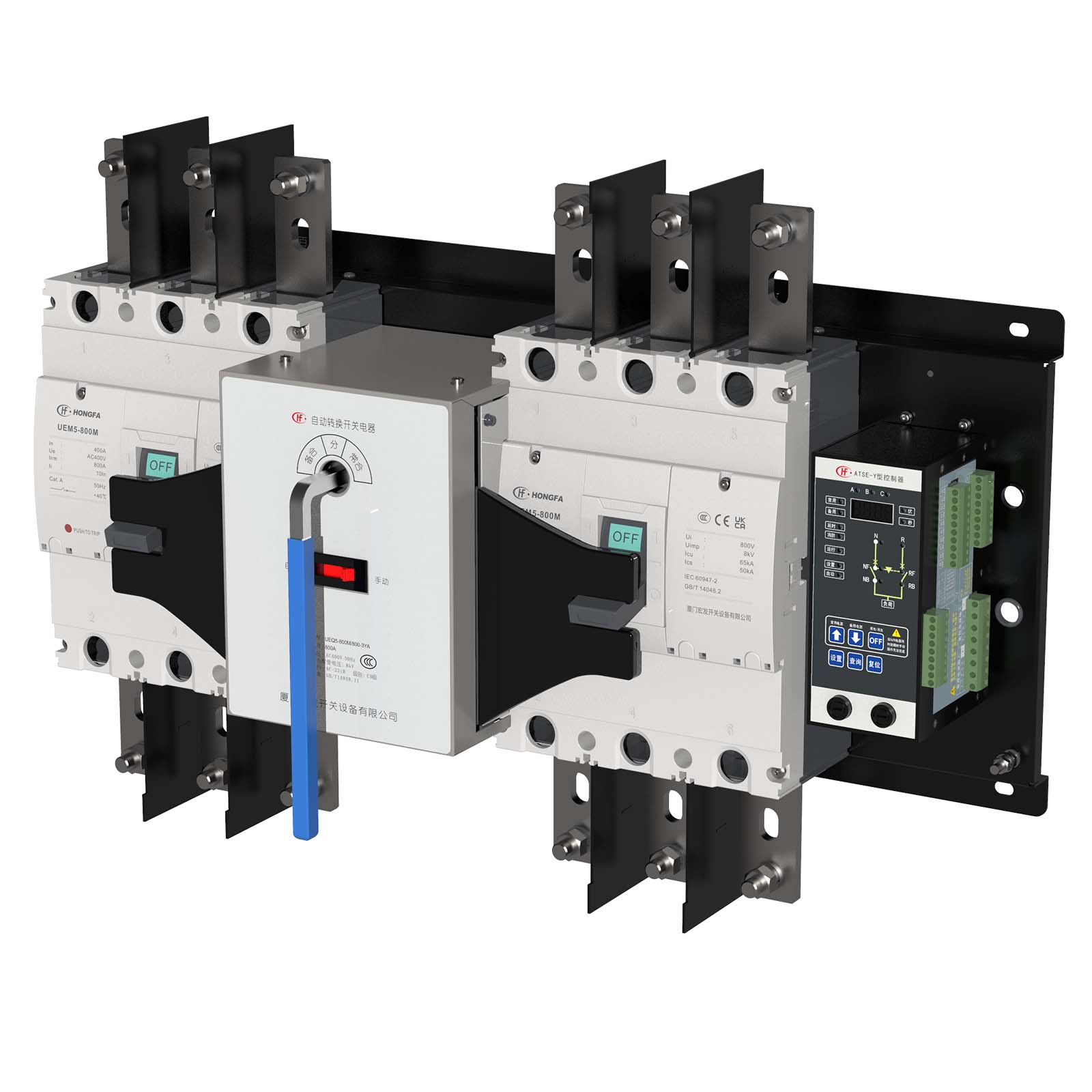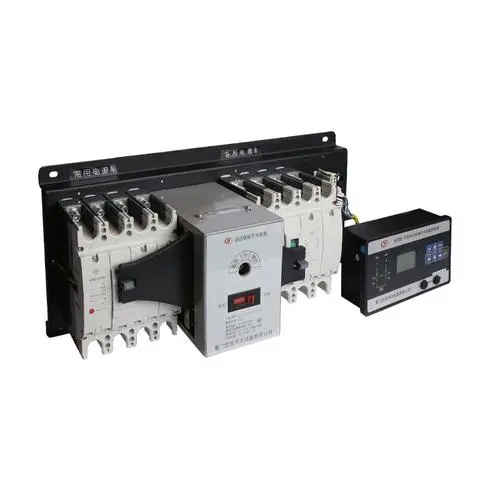In modern electrical systems, automatic transfer switches (ATS) play a vital role, especially in emergency power supply systems, which can ensure that critical loads quickly switch to backup power when the main power fails, thereby ensuring the continuity and reliability of power supply. The classification, design and application of ATS directly affect its performance and the overall safety of the system. This article will give a detailed description of ATS, explore its classification, key technical features and the differences between CB-level and PC-level ATS, and provide practical technical references for electrical design and maintenance personnel.

Automatic Transfer Switch UEQ5 series
Brief description of automatic transfer switch
Automatic transfer switch, or ATS. It is mainly suitable for emergency power supply systems with a rated voltage of no more than 1000V AC or no more than 1500V DC, and interrupts power supply to the load during power conversion.
1. Transfer switch (transfer switch)
An electrical appliance that converts one or several load circuits from one power source to another.
2. Automatic Transfer Switching Equipment (ATSE)
It is composed of one (or several) transfer switch and other necessary electrical appliances, used to monitor the power circuit and automatically switch one or several load circuits from one power source to another. In the electrical industry, it is referred to as “dual power automatic transfer switch” or “dual power switch”.
Classification of Automatic Transfer Switch
Dual power automatic transfer switch generally consists of two parts: switch body (ats) + controller.
Dual power supply is mainly divided into PC-level dual power supply (integrated type) and CB-level dual power supply (dual circuit breaker type)
The first category: It is composed of contactors (CC-level has been eliminated).
The second category: It is composed of circuit breakers (CB-level, CB-level ATSE composed of circuit breakers has non-selective protection phenomenon, the power outage area is expanded, and it cannot meet the power supply requirements of important loads).
The third category: It is composed of electric load switches (PC-level).
The fourth category: PC-level excitation integrated ATSE (PC-level).
1. PC-level dual power supply
A dual power supply that can be connected and carried, but not used to disconnect short-circuit current. If a load switch without an overcurrent release is selected as an actuator, it belongs to a PC-level automatic transfer switch. It does not have a protection function, but it has a high tolerance and connection capacity, which can ensure the safety of the switch itself and will not be damaged by faults such as overload or short circuit. In this case, a reliable connection circuit is guaranteed.
PC-level, integrated structure three-point type, it is a special switch for dual power switching, with the advantages of simple structure, small size, self-interlocking, fast switching speed (within 0.2s), safety, and reliability, but it needs to be equipped with short-circuit protection appliances.
PC-level ATSE: Only completes the function of automatic conversion of dual power supplies, and does not have the function of short-circuit current disconnection (can only be connected and carried).
2. CB-level dual power supply
A dual power supply equipped with an overcurrent release, its main contact can be connected and used to disconnect short-circuit current. If a circuit breaker with an overcurrent release is selected as an actuator for the dual power supply, it belongs to a CB-level automatic transfer switch. It has a selective protection function and can provide short-circuit and overload protection for the load and cable at the lower end; its connection and disconnection capacity is much greater than that of other components such as contactors and relays.
CB-level Automatic Transfer Switch: It not only completes the function of automatic conversion of dual power supplies, but also has the function of short-circuit current protection (can be connected and disconnected).
The difference between CB-level and PC-level
1. The design concept of the two mechanisms is different
CB-level is composed of circuit breakers, and the circuit breaker is responsible for breaking the arc, requiring its mechanism to trip quickly. Therefore, the mechanism of the circuit breaker has unreliable factors such as slipping and re-locking; while PC-level products do not have this problem, and the reliability of PC-level products is much higher than that of CB-level products.
2. The circuit breaker does not carry short-circuit withstand current, and the contact pressure is small
When a short circuit occurs in the power supply circuit, the moving contact is repelled to produce a current limiting effect, thereby breaking the short-circuit current; while the PC-level Automatic Transfer Switch should withstand an overload current of 20Ie and above. The contact pressure is large and it is not easy to be repelled, so the contact is not easy to be welded. This feature is particularly important for fire protection power supply systems.
3. There is a problem of power superposition during the conversion of two power supplies
PC-level ATSE fully considers this factor. The electrical clearance and creepage distance of PC-level ATSE are generally 180% and 150% of the electrical clearance and creepage distance of the circuit breaker, which is safer.
4. Different angles of contact material selection
Circuit breakers often choose silver tungsten and silver tungsten carbide materials to match, which is conducive to breaking the arc, but this type of contact material is easy to oxidize, and the spare contact is exposed to the outside for a long time, and oxides that hinder conductivity and are difficult to remove are easily formed on its surface. Once the spare contact is put into use, the increase in contact temperature can easily cause the switch to burn out or even explode; and the PC-level Automatic Transfer Switch fully considers the consequences of contact material oxidation.
5. The conversion speed of PC and BC is different
CB-level consists of two circuit breakers, motors, and mechanical interlocks. The switching time is 1000~2500 milliseconds. There is no guarantee of safety, but the price is low.
PC level adopts an integrated conversion structure, excitation drive, simple and reliable, fast action time, generally 100~200MS. The contact is made of silver alloy, the contact separation speed is large, and there is a specially designed arc extinguishing chamber. Small size, 1/2 of CB level. Withstands short-time current.
According to the actual project needs, choose a reasonable ATSEAutomatic Transfer Switch action time, and the Automatic Transfer Switch should be able to avoid interference such as power supply voltage flicker and transient.
6. Summary
CB level uses circuit breakers; PC level is disconnector.
Ordinary loads use CB level; fire loads should use PC level.
PC level has no short-circuit protection function; CB level has short-circuit protection function.

Automatic Transfer Switch
The selection of an Automatic Transfer Switch depends on load characteristics, safety requirements, and economy. PC level switches are suitable for fast switching and high power supply continuity, while CB-class switches are suitable for general load power supply due to built-in short-circuit and overload protection functions. Electrical engineers must consider the system’s architecture, specific needs, and coordination with other protection devices when designing and deploying an Automatic Transfer Switch. The core goal is to improve reliability and safety in power supply systems, and understanding the working principle and characteristics of these switches is crucial for stable operation in critical power systems.
Post time: 7 月-15-2024


